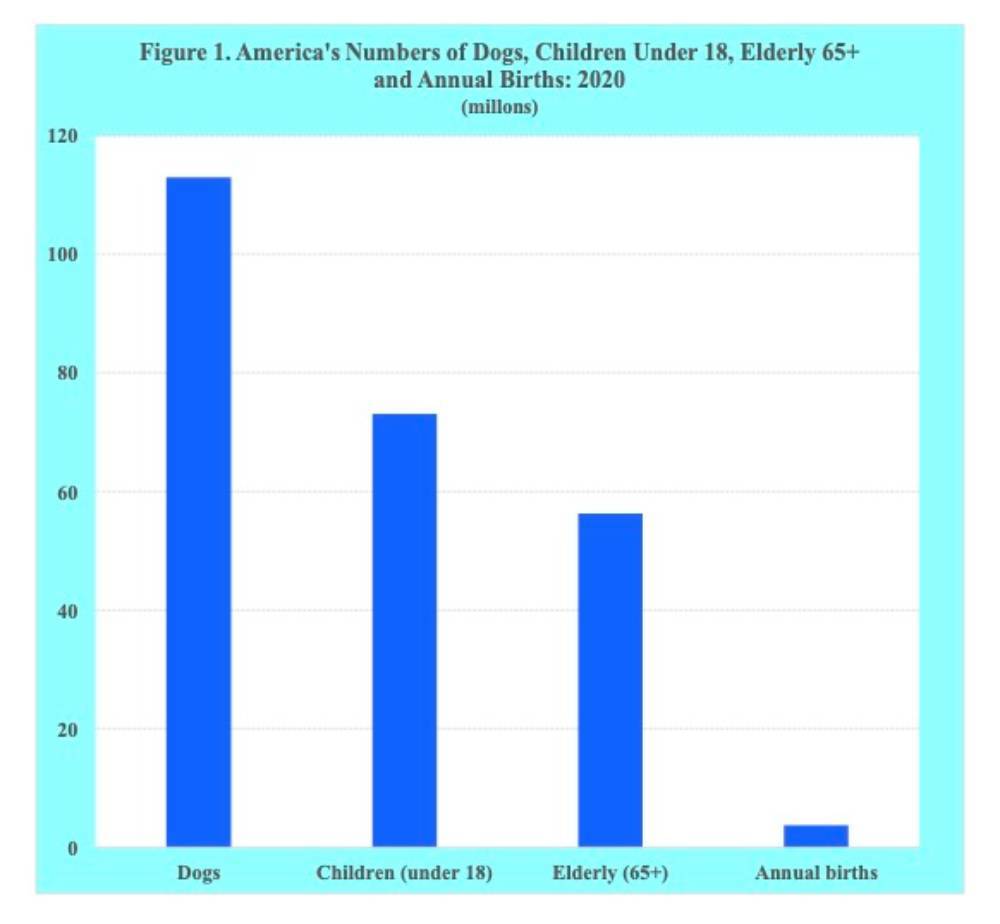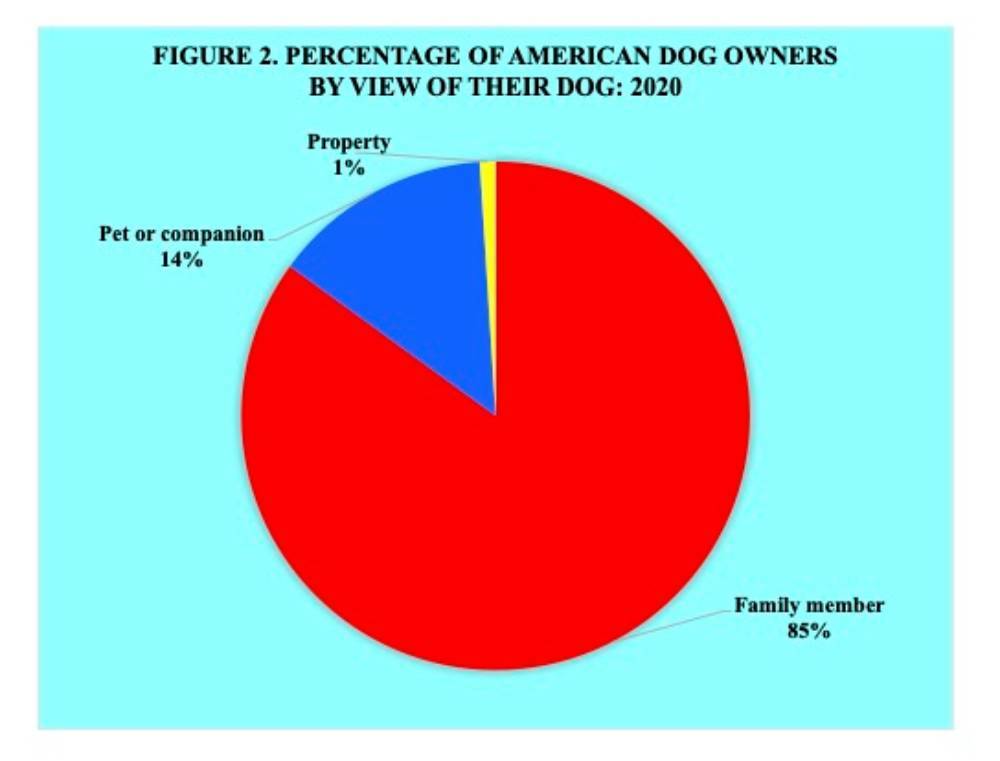Dogs constitute a mounting economic, environmental, demographic, public safety and civil rights crisis for America.
Despite the United States accounting for only 4 percent of the world’s population of 8 billion, 91 million households in America are hosting 13 percent of the world’s estimated 900 million dogs.
Moreover, the number of dogs within the borders of the U.S. is double the number of growing population of elderly Americans in 2020, estimated at 56.3 million men and women aged 65 years and older, who constitute a major fiscal problem for the government.
In addition, the number of dogs in America is 30 times greater than the total number of U.S. births in 2020, provisionally estimated at 3.7 million. Except for those in their forties, most Americans are more likely to have a dog in their home than a child. And the U.S. dog population is more than 50 percent larger than the number of America’s children under age 18 years, estimated at 73.1 million in 2020 (Figure 1).
 Source: Pet Keen and U.S. Census Bureau.
Source: Pet Keen and U.S. Census Bureau.
America’s dogs have diverse backgrounds, coming from countries all around the world. Those canine backgrounds include Afghan Hound, Belgian Malinois, Chinese Shar-Pei, French Bulldog, German Shepherd, Great Dane, Irish Wolfhound, Italian Greyhound, Japanese Chin, Maltese, Newfoundland, Norwegian Elkhound, Old English Sheepdog, Russian Toy and Scottish Terrier.
Currently, 200 dog breeds are recognized by the American Kennel Club. The most popular breeds among Americans are Labrador and Golden Retrievers, French Bulldogs and Poodles, German Shepherds and Beagles. About half of the dogs within the U.S. are pure breed and the half are mixed breed, which are sometimes called mongrels or mutts, with two or more different breeds in their lineage.
Despite their friendly and loving depiction by the pet industry, media and family movies, some dogs are violent and attack people. It is important to note, however, that it is not a dog’s breed that determines whether it is violent and will attack, but rather its history and early training.
Annually more than 4.5 million Americans are bitten by dogs, with 800 thousand receiving medical attention. Dog violence and bites pose a serious health risk for Americans, especially in crowded urban areas.
Turning to its impact on the environment and pollution, the average dog in America produces 0.34 kilograms, or 0.75 pounds, of waste per day. On an annual basis that waste amounts to 124 kilograms, or 274 pounds. For the country as a whole with its many millions of dogs, the total amount of dog waste per year is estimated at 14 billion kilograms, or 31 billion pounds, and all of that is polluting the land, waterways and some of it getting on Americans’ shoes.
With respect to the important economic dimension of the dog crisis, the average annual cost in 2020 of hosting a dog in an American household was 1,200 dollars. That cost includes dog food, veterinary care, grooming, supplies, etc. When tallied across the country, the annual expenditures on dogs in America amount to more than 100 billion dollars per year.
For a comparative perspective, it should be noted that the annual cost for dogs in America is 10 percent of the Social Security benefits paid out in 2020 and 12 percent of Medicare benefit payments. The annual canine cost is approximately 10 of percent of the U.S. federal defense expenditures. Also, it is more than double the fiscal year 2023 budget for the U.S. Agency for International Development.
The costs for dogs in America could also be redirected to address the nation’s rising national debt. If the annual canine cost for the country went toward the national debt, it would pay approximately 25 percent of the annual federal interest payments, which totaled about 396 billion dollars for fiscal year 2022.
Moreover, the large majority of dogs in America are not employed. They remain lounging in homes and backyards. Some dogs, however, do have jobs, such as service dogs, therapy dogs, and search and rescue dogs. In addition, federal agencies use about 5,000 dogs to detect explosives, narcotics and other hazardous things.
Despite the worrisome demographic, economic, compositional and environmental aspects of the dog crisis, the political response has been disappointing. After several promising attempts, even with dogs visibly residing, eating and being cared for in the White House, Congressional leaders have not been able to bridge the wide gap between Democrats and Republicans on how to address the dog crisis.
U.S. courts have been reluctant to become involve in the contentious debate. Most legal experts, especially those advocating originalism in constitutional interpretation, view the mounting dog crisis to be a matter for Congress to resolve.
The Supreme Court’s decision in 2022, however, overturned the decades-old court decision that had established the fundamental right of all Americans, even adolescents, to decide freely on dog ownership without government interference.
The Supreme Court’s conservative majority found that there is no constitutional right to dog ownership comparably to the right to keep and bear arms, which is enshrined in the Second Amendment of the Constitution’s Bill of Rights. That decision is at odds with the views of the large majority of Americans who say dog ownership should be legal in most or all cases.
Following the high court’s historic decision, the dog crisis has been rolled back to the states. Some states have existing laws preventing pet stories from selling inhumanely bred puppies. Other states contend that dog ownership is a matter of choice and the government should not restrict or place limits on that decision.
Most states, however, have laws making it mandatory for dog owners to have their dogs licensed, i.e., legally registered, with the license visibly displayed and renewed each year. A dog without a license, commonly called an unauthorized dog, may be found in violation of the law and the dog’s owner may be obliged to pay a hefty fine, although the law is typically unenforced.
The dog crisis is clearly reflected by the approximately 6.5 million dogs that enter shelters across the country each year with nearly a quarter of them, about 1.5 million dogs, being euthanized, i.e., killed annually. Also, of the owned dogs in the country, about three-quarters have lost their reproductive capacities, having been spayed or neutered.
In addition, a growing number of animal shelters are packed and unable to accept all dogs needing shelter. The result is more and more dogs go homeless and end up living on the streets. The shelters are also facing a potentially fatal pet adoption crisis that has worsened overcrowding due to the COVID-19 pandemic.
Despite the million plus dogs euthanized annually, the millions of dogs losing their reproductive abilities and the growing number of homeless dogs, fiscal conservatives are opposed to raising taxes. They contend that dog owners, animal shelters and Americans sympathetic to the plight of dogs should be primarily responsible for carrying the economic burden of the crisis.
National surveys clearly show that Americans are closely attached to their dogs. The overwhelming majority of U.S. dog owners, approximately 85 percent, consider their dogs to be family members. Another 15 percent of dog owners consider their dogs to be pets or companions, with only 1 percent considering their dogs to be property (Figure 2).
Given the views of Americans toward their dogs, the dog crisis is expected to be a major focal point of controversy in the 2024 presidential election. The issue, which is on par with the Republican proposed cuts to Social Security and Medicare entitlements, is expected to be a decisive issue among voters in the western swing states of New Mexico, Idaho, Colorado, Montana and Nevada where the rates of sheltered dogs relative to population are the highest.
Members of Congress continue to avoid addressing America’s dog crisis, with many refusing to cooperate with the House Select Committee to Investigative Dogs in America. They prefer to use the crisis to score points against their political adversaries with hopes of winning the White House.
The continuing partisanship, however, only worsens the dog crisis by slowing down the growth of the economy, impacting the environment, worsening public health and safety, exacerbating social divisions among groups, and harming the wellbeing of millions of dogs, especially those forced to be homeless. It’s time for Congress to put aside partisan politics and resolve the mounting dog crisis.
















